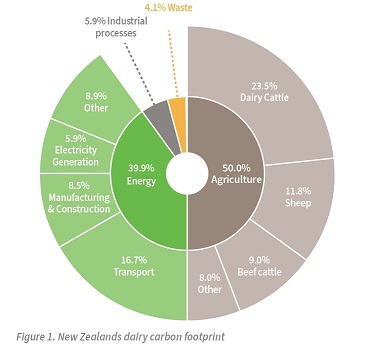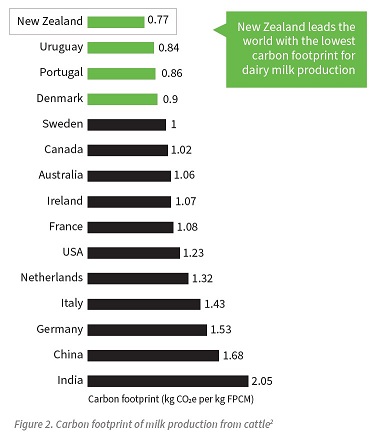Animal Efficiency
Greenhouse gas emissions and why we need to reduce them
The earth is warming at an unprecedented rate. Global warming is largely being driven by human activity causing increased levels of greenhouse gas emissions (emissions) into the atmosphere and this is contributing to climate change. Half of New Zealand’s emissions are from agriculture, including 23% from dairy farming1 (Figure 1). This is in contrast to most other developed countries where agricultural emissions account for approximately 12%.

Increasingly countries and businesses world-wide are seeking to reduce their emissions and hence carbon footprint. Global dairy customers have set ambitious emissions reduction targets and if the New Zealand (NZ) dairy sector wants to remain internationally competitive it is crucial that these expectations are met.
NZ dairy farmers are well positioned, with the lowest global carbon footprint for milk production2 (Figure 2). However, with approximately 90% of the carbon footprint from exported dairy products coming from on-farm emissions3, farmers need to take action now to further reduce these.

Improving animal efficiency has multiple benefits
Improving animal efficiency is one of the key ways to reduce emissions intensity (emissions/kg milksolids), with the added benefits of improving animal wellbeing and farm profitability at the same time.
Animal efficiency is the relationship between inputs and outputs, i.e. the dry matter eaten for milksolids produced. The primary goal is for a cow to produce more milk in her lifetime, through more milk per lactation, and more lactations per lifetime. The key drivers of animal efficiency are health status, reproductive performance and longevity.
Vets have a critical role to play in supporting their farmers to improve animal efficiency in the following areas:
- Nutrition
- Health – including reducing mastitis and lameness
- Environmental stress
- Genetics
- Reproduction – including earlier in-calf rates
There are a wealth of resources available to support farmers in their journey to improving animal efficiency and hence reducing emissions intensity:
Technical Bulletin VM4 - How animal efficiency impacts on-farm emissions
Resources to help reduce mastitis
Resources to help reduce lameness
Resources to help improve milk production efficiency
Resources to help improve early in-calf rates:
Non-cycling cows
Why Wait for cycling cows
Oestrus synchrony
Endometritis
Other resources:
Sample Fonterra Farm Insights Report
Fonterra’s "Our approach to on-farm emissions"
DairyNZ agricultural greenhouse gases
References
1https://environment.govt.nz/pu...
2Mazetto AM, et al. Mapping the carbon footprint of milk production from cattle: A systematic review. J Dairy Sci. 105:12, 9713-9725, 2022
3Our approach to on-farm emissions, Fonterra, 2023
Animal Efficiency
Greenhouse gas emissions and why we need to reduce them
The earth is warming at an unprecedented rate. Global warming is largely being driven by human activity causing increased levels of greenhouse gas emissions (emissions) into the atmosphere and this is contributing to climate change. Half of New Zealand’s emissions are from agriculture, including 23% from dairy farming1 (Figure 1). This is in contrast to most other developed countries where agricultural emissions account for approximately 12%.

Increasingly countries and businesses world-wide are seeking to reduce their emissions and hence carbon footprint. Global dairy customers have set ambitious emissions reduction targets and if the New Zealand (NZ) dairy sector wants to remain internationally competitive it is crucial that these expectations are met.
NZ dairy farmers are well positioned, with the lowest global carbon footprint for milk production2 (Figure 2). However, with approximately 90% of the carbon footprint from exported dairy products coming from on-farm emissions3, farmers need to take action now to further reduce these.

Improving animal efficiency has multiple benefits
Improving animal efficiency is one of the key ways to reduce emissions intensity (emissions/kg milksolids), with the added benefits of improving animal wellbeing and farm profitability at the same time.
Animal efficiency is the relationship between inputs and outputs, i.e. the dry matter eaten for milksolids produced. The primary goal is for a cow to produce more milk in her lifetime, through more milk per lactation, and more lactations per lifetime. The key drivers of animal efficiency are health status, reproductive performance and longevity.
Vets have a critical role to play in supporting their farmers to improve animal efficiency in the following areas:
- Nutrition
- Health – including reducing mastitis and lameness
- Environmental stress
- Genetics
- Reproduction – including earlier in-calf rates
There are a wealth of resources available to support farmers in their journey to improving animal efficiency and hence reducing emissions intensity:
Technical Bulletin VM4 - How animal efficiency impacts on-farm emissions
Resources to help reduce mastitis
Resources to help reduce lameness
Resources to help improve milk production efficiency
Resources to help improve early in-calf rates:
Non-cycling cows
Why Wait for cycling cows
Oestrus synchrony
Endometritis
Other resources:
Sample Fonterra Farm Insights Report
Fonterra’s "Our approach to on-farm emissions"
DairyNZ agricultural greenhouse gases
References
1https://environment.govt.nz/pu...
2Mazetto AM, et al. Mapping the carbon footprint of milk production from cattle: A systematic review. J Dairy Sci. 105:12, 9713-9725, 2022
3Our approach to on-farm emissions, Fonterra, 2023
No Products Found